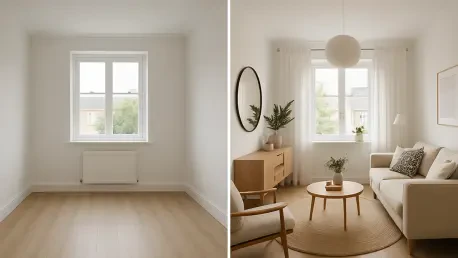Imagine walking into a room that feels like a sterile white box, devoid of personality or warmth, where the blank walls seem to echo with emptiness rather than inspiration, leaving you yearning for a space that truly reflects your style. A white room holds immense potential as a clean slate, yet it often falls flat without the right touches to bring it to life. Many homeowners and renters struggle with this challenge, finding it difficult to turn a stark space into something vibrant and inviting. The good news is that transforming such a room doesn’t require a complete overhaul or a hefty budget. With a few strategic changes, even the most uninspired white space can become a canvas for creativity. Interior design experts have shared actionable insights that can help anyone breathe character into their home. By focusing on intentional additions and subtle contrasts, a dull room can evolve into a thoughtfully curated environment. The following tips offer a roadmap to achieving this transformation, proving that small adjustments can yield dramatic results without the need for major renovations.
1. Curate Like a Museum
Turning a white room into a captivating space starts with adopting the mindset of a museum curator, where every piece is chosen with purpose and displayed for impact. A white backdrop, much like the walls of an art gallery, provides the perfect opportunity to highlight standout items. The key lies in avoiding elements that blend into the background, such as all-white furniture, which can make the room feel even more monotonous. Instead, focus on introducing pieces that demand attention through bold colors, unique materials, or distinctive shapes. For instance, a dark red lacquer coffee table can add depth without overwhelming the space, while aligning with trendy finishes. Similarly, an accent chair with a linen blend and a rolled-back design can bring texture and soft hues into play. These selections create contrast against the white walls, shifting the mood from flat to dynamic and ensuring each item feels like a deliberate part of the room’s story.
Continuing with the museum-inspired approach, consider smaller yet impactful additions that enhance the overall aesthetic without cluttering the space. A chrome-inspired cast aluminum drink table with a fluid, looped design can introduce a sense of movement, mimicking the effect of a gallery exhibit. Such pieces don’t just serve a functional purpose; they act as conversation starters and visual anchors in an otherwise plain setting. The goal is to build layers of interest, ensuring that every corner of the room contributes to a cohesive yet striking look. When selecting furniture or decor, think about how each item interacts with the white canvas—does it stand out enough to break the monotony? By prioritizing contrast and intentionality, the room begins to feel less like an empty box and more like a curated collection of artful elements. This method proves that even minimal changes can transform the perception of a space, making it feel thoughtfully designed and full of personality.
2. Upgrade Your Lighting
Lighting plays a pivotal role in altering the ambiance of a white room, especially when architectural details are scarce, and swapping out basic fixtures for artistic ones can make a world of difference. A standard overhead light often fails to add character, but replacing it with something sculptural or visually striking can instantly elevate the space. Think of lighting as a focal point that catches the eye upon entering the room—something more akin to a piece of art than just a source of illumination. Options like plug-in wall sconces or bold overhead fixtures offer an accessible way to achieve this effect, even on a tight budget. For smaller spaces, a colored glass flush light with warm gold tones can provide a sleek yet impactful update. Such changes are surprisingly simple to implement, often requiring minimal effort for a significant transformation in how the room feels.
Beyond the initial swap, the choice of lighting can also influence the room’s warmth and tone, countering the coldness often associated with white walls. An ivory silk sculptural chandelier, for example, serves as a subtle centerpiece while casting a radiant glow that softens the starkness of the surroundings. For those seeking a more timeless appeal, a vintage-inspired Art Deco chandelier with textured glass shades can diffuse light beautifully, adding elegance without overpowering the simplicity of the space. These selections demonstrate that lighting isn’t just functional—it’s an opportunity to introduce personality and intention. By prioritizing fixtures that double as design elements, the room gains a sense of depth and sophistication. This approach underscores the transformative power of even minor updates, showing how a single change can redefine the entire atmosphere of a plain white environment.
3. Incorporate Oversized Artwork
Empty white walls can feel oppressive without something to break up the monotony, and introducing oversized artwork offers a dramatic solution to this common issue. Large-scale pieces, such as vintage paintings or expansive tapestries, have the power to shift a room from barren to expressive by drawing the eye and creating a strong focal point. Unlike smaller frames that might get lost on vast blank surfaces, bigger art commands attention and balances the space. Affordable options can be sourced from thrift stores or online marketplaces like eBay and Etsy, making this an accessible way to add sophistication. A vibrant oversized canvas with dynamic movement, for instance, can inject color and energy into the room, while a jacquard-printed cotton tapestry with vintage roots serves as an instant conversation piece, easy to hang and admire.
Exploring further, oversized artwork also allows for personal expression, enabling the integration of individual tastes or interests into the decor. A large framed piece depicting whimsical golfers on a green background can subtly nod to a hobby while maintaining a stylish, tranquil aesthetic suitable for various rooms. The key is to think beyond traditional art forms—quilts, wall hangings, or even unique thrift finds can achieve the same effect at a fraction of the cost. These additions not only fill the visual void but also contribute to a sense of curated luxury, making the space appear more expensive and intentional. When positioning such pieces, consider their scale in relation to the wall and surrounding furniture to ensure harmony. This strategy highlights how a single bold statement can redefine the room’s character, turning a blank slate into a gallery-like setting that feels both personal and polished.
4. Introduce Artistic Decor Pieces
In a minimalist white space, everyday objects like lamps or small decor items should do more than serve a purpose—they should act as sculptures that bring personality and depth to the room. These elements take on heightened importance when the backdrop lacks color or texture, requiring them to provide the visual interest that the walls cannot. Focus on materials and shapes that stand out, such as a whimsical brass sconce resembling blooming flowers, which can add charm to a bedside or living area. The goal is to select pieces that feel like art installations, transforming mundane corners into points of intrigue. Whether it’s a portable lamp or a thrifted vintage find, each item should contribute to the overall narrative of the space, ensuring that no detail is overlooked in the pursuit of a more engaging environment.
Delving deeper into this concept, consider how texture and color in decor can counterbalance the simplicity of a white room without overwhelming it. A burgundy velvet table lamp, for instance, introduces a rich, moody tone and a tactile quality that contrasts beautifully with the plain surroundings. Similarly, a vintage-style floor lamp with ribbed glass and brass accents can bring warmth to under-decorated areas, appealing to both maximalist and minimalist tastes. These choices emphasize the importance of intentionality—each piece should be selected for its ability to enhance the room’s aesthetic rather than simply fill space. By treating decor as art, the space gains layers of complexity that prevent it from feeling sterile. This approach showcases how small, carefully chosen additions can significantly alter the perception of a room, making it feel curated and lived-in rather than empty and uninspired.
5. Revamp Your Window Coverings
Window treatments are often an overlooked aspect of design, yet they hold immense potential to add warmth and texture to a white room that desperately needs contrast. Cheap plastic blinds or basic white curtains do little to enhance the space, often reinforcing its cold, unfinished look. Instead, opt for materials like bamboo or subtly colored linen that introduce a sense of coziness while breaking up the monotony. A light-filtering matchstick bamboo blind, for example, offers a natural touch suitable for various settings, from sunrooms to kitchens, while maintaining a clean, cord-free design. For renters or those hesitant to make permanent changes, layering curtains over existing blinds or using tension rods can achieve a similar effect. This simple update can dramatically alter how the room feels, proving that even minor tweaks can have a substantial impact.
Expanding on this idea, window coverings also provide an opportunity to experiment with subtle patterns and textures that complement the minimalist backdrop. Sheer gauze curtains with vertical stripes and ribbon ties can add an airy, light feel while incorporating a hint of detail that elevates the space. Alternatively, semi-sheer linen blend cafe curtains, which follow a popular trend, bring warmth and privacy to smaller windows without overpowering the room’s simplicity. These options demonstrate how window treatments can serve as both functional and decorative elements, softening the harshness of white walls and creating a more inviting atmosphere. When selecting drapes or blinds, consider how they interact with natural light and the overall color scheme to ensure cohesion. This final touch underscores the value of accessible changes, showing that even the smallest updates can contribute to a more polished and harmonious living space.
Bringing It All Together: Small Steps to Big Impact
Reflecting on the journey to revitalize a dull white room, it became clear that transformative design doesn’t demand drastic measures or bold overhauls. Each step, from curating standout furniture to upgrading lighting, adding oversized art, incorporating sculptural decor, and revamping window treatments, played a crucial role in reshaping the space. These efforts proved that even the simplest adjustments carried significant weight when executed with intention. Looking ahead, consider experimenting with one or two of these ideas to test their impact before committing to a full transformation. Mixing and matching elements based on personal style can further customize the result, ensuring the room reflects individual tastes. For those eager to dive deeper, exploring local markets or online platforms for unique finds can uncover hidden gems that elevate the design. Ultimately, the focus should remain on building a space that feels thoughtful and expressive, demonstrating that impactful change often stems from the smallest, most deliberate actions.









